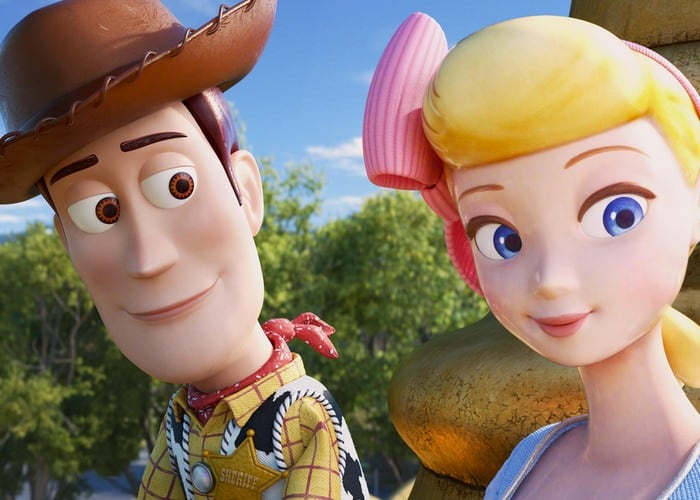
After Toy Story 3, Pixar announced it had no plans to make a fourth and wouldn’t entertain the idea unless an extraordinary addition was on the table. Whether Toy Story 4 is equal to, or better than, the other three will be hotly debated amongst fans, but at the end of the day, it’ll be a win-win argument. Because, at the very least, the new sequel is undoubtedly on par with its predecessors.
At the start of Toy Story 4, we flip the page to the next chapter only to find ourselves in the past, “nine years ago,” around the time Toy Story 2 takes place. All your favorite toys — you know, the ones you didn’t grow up with but feel like you did, or did grow up with as an extension of an onscreen experience — are there: Woody (Tom Hanks), Buzz Lightyear (Tim Allen), Rex (Wallace Shawn), Hamm (John Ratzenberger), Slinky Dog (Blake Clark), Jessie (Joan Cusack), Mr. Potato Head (archived voice clips from the late Don Rickles), Trixie (Kristen Schaal), Bo Peep (Annie Potts), and more. The group is performing a Rube-Goldberg rescue mission for their racecar pal RC, who’s in danger of being washed away by a riotous rainstorm into the realm of lost toys, which serves as the thematic nucleus of a film that deals heavily with what it means to be lost, alone, and without purpose.
But this isn’t Up or The Land Before Time. We don’t kick off with a gut-wrenching tragedy. They save RC. But it doesn’t take long before Woody is put in a tough position. Andy’s sister Molly is getting rid of some things and Bo Peep is the chief loss among them. Woody must choose to get in the giveaway box with Bo or hang back with his family, Andy’s toys. He’s tempted, hands resting on the edge of the box ready to hoist him over and inside, but in a moment of ontological transparency, he hears Andy’s worried cries and decides to stay. Andy needs him, and he knows it. Enter: Randy Newman.
If there’s one thing the experienced Pixar filmmakers knew they had to do besides bring back Woody, Buzz, and the gang, it was to rehire Newman with his saga-defining music. And boy, does he deliver. After Woody says goodbye to Bo Peep, we’re thrust into a near-decade-spanning montage of Andy playing with the toys set to Newman’s iconic theme song “You’ve Got a Friend in Me.” It’s lovely — heartwarming, familiar, and effective enough to conjure a happy tear or two. It also catches us up to the present. The toys are now with Bonnie (Madeleine McGraw), basically right where we left off in Toy Story 3.
Bonnie is about to start kindergarten, and she wants to bring a toy for comfort, but Mom and Dad want her to meet new friends and acclimate without the crutch of her playthings. Woody, on the other hand, knows the heartening effect a toy has on its child, and, after a disappointing stint of not being played with, he decides to reinvigorate his relevance by saving the day. He sneaks into Bonnie’s backpack. At school, he keeps hidden but makes a constant concerted effort to ensure Bonnie’s first day is a good one. He sneakily slides a spork, some popsicle sticks, googly eyes, and pipe cleaners in front of her, and the next thing you know, we have the most delightfully silly character to be introduced in the saga since Buzz himself.
They call him Forky (Tony Hale), and he is adorably peculiar. Forky is made from trash, so he thinks he’s trash. Every time he spots a garbage bin, he excitedly jumps in and burrows. Woody takes it upon himself to talk him off the ledge every time. In a strangely dark sense, the characterization of Forky is that of a compulsively suicidal lunatic, or at least someone who wants to jettison himself into the dominion of unwanted things, albeit unaware of the meaning behind his actions. Yet it’s hilariously lovable because death isn’t imminent. Forky wants to cuddle up next to some cozy scrap paper.
The combination of Hale squeakily and enthusiastically shouting “Trash!” along with Forky’s barebones aesthetic and hurried waddle towards garbage forms a very lighthearted tone about the whole thing. But you also can’t ignore what Forky’s innate desire represents on a metaphorical level. If we think our essence is trash, we’ll think we’re trash. And if we believe we are trash, we’ll treat ourselves like trash. Woody’s job is to convince Forky he’s a toy now. He’s alive. He’s loved. He serves a purpose. He’s no longer trash.
The slapstick bit continues when Bonnie and family go on an RV road trip and take the toys along. At every rest stop and restaurant, Forky spots a garbage bin and charges as if the pearly gates of heaven have swung open just for him. Meanwhile, Woody exhausts himself keeping Forky from the trash, knowing that Bonnie would be a wreck without her new favorite toy. But eventually, Forky escapes and Woody chases him. From that point on, we leave the old Toy Story characters behind in the RV and spend most of our time with the new ones.
Forky is only one of several wonderful additions, which include Bunny and Ducky (an intuitive pairing of the former comedy duo Keegan-Michael Key and Jordan Peele), Duke Caboom (the internet’s new boyfriend, Keanu Reeves), and the least villainous villain you’ve ever met, Gabby Gabby (Christina Hendricks), a creepy unowned doll whose name, archetype, and terrifying ventriloquist puppet henchmen summon memories of The Simpsons’ Gabbo. After Woody and Forky have a run in with Gabby in her antique store home, it’s revealed that Gabby’s voice box is broken.
Moreover, she believes that a working voice box will be enough to get the attention of Harmony (Lila Sage Bromley), the granddaughter of the antique store owner. Because Gabby, like all toys, wants a kid she can make happy. Like the rest of us, she yearns for community and meaning. Once she learns that Woody’s voice box is still intact, she sets her sights on stealing it. Woody and Forky are separated, and Woody runs into Bo Peep. The two, along with Bunny, Ducky, Duke, Giggle McDimples (Ally Maki), and Bo’s sheep, Billy/Goat/Gruff, set out to get Forky back from the sad, twisted world of unwanted toys that is the antique store.
There’s a certain rapport between Pixar and prestige, but it’s not as strong as the rapport between Pixar films and their audiences. At the heart of that relationship, there’s Toy Story — the original 1995 project and the founding father of the predominant studio’s evolutionary recalibration of the animated film scene over the past 24 years (a number that elicits an “It’s already been 24 years?” reaction as strongly as it does an “It’s only been 24 years?” reaction). Besides being the longest standing Pixar story, it holds the studio’s record for the narrative with the most sequels.
In other words, the Toy Story saga is a microcosm of Pixar’s pop cultural resonance and industry exceptionalism. Every chapter has resonated enormously with young and old audiences alike, and we know this because we keep praising them — critics as much as fans — and coming back for more. The buzz (pun intended) over first-time director Josh Cooley’s Toy Story 4 has been nothing short of cult status. And it’s well deserved.
Sure, it might be the worst of the four, but that’s a claim that needs to be understood in the context of the pop cultural craving for rankings and binaries (“better” and “worse”). In reality, all four movies belong in the same tier of quality and rewatchability — the humor flourishes. The on-the-nose message is deeply felt and legitimately vital enough to be excusable. It steers clear from feeling like a Toy Story template. It has a cast of cameos worthy of It’s a Mad, Mad, Mad, Mad World (Carl Reiner, Betty White, Carol Burnett, Mel Brooks, Alan Oppenheimer, Bill Hader, Patricia Arquette, Timothy Dalton, Flea, Laurie Metcalf, Jeff Garlin, Estelle Harris, June Squibb, and Bonnie Hunt!).
From Rex’s ploy to get Bonnie’s dad (Jay Hernandez) arrested to Duke’s insistence upon incessant posing to Bunny and Ducky’s witty banter to the ignored snow patrol Combat Carl (Carl Weathers) to Forky’s very existence, the movie lands nearly every joke. But, outside of some recent sour sequels (Cars 3, Finding Dory), we’ve come to expect that level of comedic consistency from Pixar. Likewise, we’ve come to expect an emotional heart to every Pixar film — one that sends 10-year-olds out of the theater thinking, just as it does their parents.
Toy Story 4 might as well be an old Kanye West album for how deliberately, constructively, and conclusively it convinces us that we’re worth something. It’s hard to wake up the morning after Toy Story 4 and not lovingly think about the people who keep you from feeling “lost” or “disowned.” Like sickness does for health, it imbues a profound appreciation for what it means to be part of a healthy community. Yet, like Toy Story 3, it reminds us that life is full of difficult changes that will eventually be rewarding if we can muster up the courage to find and follow our inner voice (which, it should be said, is not inherently an innately good voice, but one that is good when we approach it wisely and temperately). It also reminds us that we’re not alone. The lost will find the lost just as the found might find them. Whatever the case, nobody deserves to be alone, and nobody has to be.
The movie has very few stains, but they’re there. For example, the pervasive ambiguity of the screenplay’s voice — a direct product of the unnecessarily messy, overly collaborative screenwriting process that renders the film virtually screenwriter-less — or the lack of confidence to simply leave a villain out of it when it’s clear there really isn’t one, or the disappearance of Forky in the late-second and third acts. But it’s hard to fault a film for not having enough of something it introduced us to in the first place. And, quite frankly, I’ll take whatever time with Forky I can get, and I swear I won’t complain if it means he’ll be back in Toy Story 5 (there’s bound to be four more of these over the next 24 years, right?).
As John Lasseter’s last collaboration with Pixar (rightfully so, thank goodness), the final Pixar film of a very fruitful decade in the 2010s, a memorable addition to a remarkable tetralogy, a strikingly weird narrative that will hopefully stretch audiences’ originality tolerance in summer movies, and a downright exceptional film across the board, Toy Story 4 is a fantastic and felicitous send-off into the next decade of Pixar imagination. And if the end is at all representational of what’s to come — i.e., Pixar takes its own advice — the next era will be just as fresh, bold, acute, and tearjerkingly phenomenal as the history of films it’s founded on.
Related Topics: Annie Potts, Jordan Peele, Keegan-Michael Key, Pixar, Tim Allen, Tom Hanks, toy story, Toy Story 4

